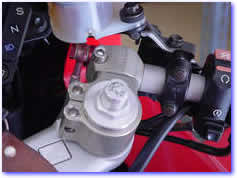
 |
Yoshimura
RS-3 slip-ons w/ ZRS baffles
|
The engine can rev a bit quicker but there is no extra power. Luckily the jetting works fine. While I could use 10-20 more hp, screwing with those big carbs is a good deterrent to mounting a full exhaust system.
 |
Lockhart
Carbon Fiber
Rear Fender |

 |
Turn Signals |  |
The rear turn signals are from an Aprillia Mille. They are a lot smaller than stock, but still very bright. The problem with most aftermarket signals is they are very dim. You have to install brighter bulbs in these to get the blink rate correct, but the bulbs are easy to find (use the ones out of the stock signals). These require a bit more work to adapt to a Honda. I cut the wires off the OEM's and soldered them to these to gain the extra length and to insure the connectors are proper. They bolt directly in place of the stockers and reflect just as bright as the originals. While I was back there, I hacked down the huge original mudflap. I personally think the aftermarket eliminator kits look crude, and this still looked "factory" enough to not draw attention from Johnny Law.
 |
Stainless
Steel
brake lines |
 |
One of the best mods for the VTR is to replace the stock rubber front brake lines. G&G brand lines fit well and are covered in clear plastic to stop abrasion damage. The stiffer lines give much better feel when you first touch the brakes,and don't fade as quickly. The OEM routing has a splitter on the triple clamp, which is one more place for air to get trapped. A two-line front sends one direct line to each caliper. Make sure to cover any plastic parts before messing with brake fluid, as it will stain anything it comes in contact with. I have been using Braking brand pads. They have much stronger initial bite than the originals and do not squeal or wear the rotors. Since they were getting a bit thin, the lever would get a bit mushy (technical term, don't want to confuse you..) with only a little heat, so I recently installed EBC Sprint compound pads and they have as much bite as the Braking pads.
Since the bleeder is on top of the caliper, the easiest way to keep fluid off the pads when bleeding is to unbolt the calipers and remove the pads. Be sure it insert something in place of the pads to keep the pistons from popping out when you pump the lever. A block of wood works well, though I just but the stock junk pads back in and then clean the whole assembly with brake cleaner when done.
I bleed mine often, as I believe the excess vibration through the handlebars
causes the fluid to foam quickly, and the translucent reservoir allows sunlight
to decay the DOT 3. If I only ride on weekends, I flush the system about every
three months. Whenever the brakes get soft enough to need to adjust the lever
out from the bar, it is best to get some fresh juice in there.